Albany Protest Demands
• Full Funding Now! Our Schools, We Decide!
• A Lesson in Hypocrisy and Double Standards
Reject Cuomo's Anti-Education and Anti-Democratic Plans
• State Receivership Is No Solution
• Lawrence Receivership Example and Issues of Decision Making
Albany Protest Demands
Full Funding Now!
Our Schools, We Decide!

On March 11, students, teachers, parents and delegations from across the state rallied and marched in Albany, demanding that Governor Cuomo provide full funding now for education at all levels. The delegations included those from schools, parent-teacher associations, unions, athletic and community organizations, as well as cities from across the state. Buffalo brought about three busloads, despite efforts by school officials to block students and teachers from going.
Marching bands and drill teams added to the spirit of the rally at the armory and the march to the capitol building. Through various signs and chants, demonstrators defended the equal right to education for all and denounced Governor Cuomo for holding our public dollars hostage to his destructive and anti-democratic legislative demands. As one banner from young students put it, reflecting their anger with unfair testing and its result of pushing many students out the door, 1, 2, 3, 4, Push Cuomo Out the Door; 5, 6, 7, 8 Give Us Our Money Today!
Teachers and students took their stand against Common Core and its anti-education testing regime, with calls to Opt Out! of testing and that student success does not exist under Common Core testing. Signs and chants also brought forward the right of the public to decide issues of education: Buffalo Says: Public Control of Public Schools! Democracy Means Student, Teachers and Parents Decide; #We Can’t Wait for Full Funding Now! Whose Schools? Our Schools! Who Decides? We Decide!
Rally at the Armory
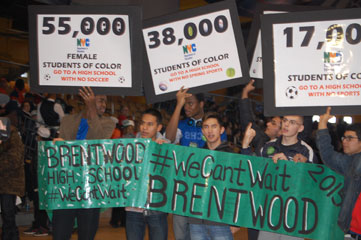
![]()


![]()

March to Capitol Building
![]()

![]()

![]()

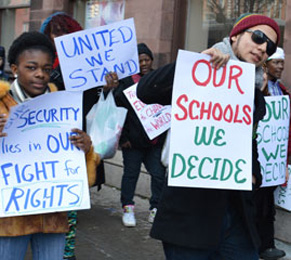
![]()
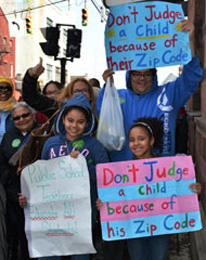

![]()


![]()


![]()


Organized mainly by Citizen Action and the Alliance for Quality Education, along with other organizations, the march went from the armory to the capitol building, where some lobbied legislators while others rallied at the Senate staircase. The action concluded with all rallying at Cuomo’s office in the Senate building. We Can’t Wait! was the call, for full funding now and equal rights for all. We Can’t Wait! for physical education, art and music for all. The strong spirit was to resist Cuomo’s anti-democratic action of trying to blackmail all into accepting his destructive anti-education plans.
Cuomo states in his budget proposal “A year-to-year increase of $1.1 billion is contingent on the implementation of improvements to the systems for teacher preparation, evaluation, certification and tenure, as well as providing the authority to truly improve failing schools and providing increased support and accountability to charter schools.”
When Cuomo speaks of “providing authority” to “improve failing schools,” what he has in mind is appointing a single individual with complete control. Called a receiver, or czar, or dictator, this individual would determine — for each school in a given district — budget, hiring and firing, curricula, discipline, testing, “performance” and related bonuses, length of school day and year, and more. The aim is to try and destroy school districts, unions, parent groups and collective action for rights. It is to remove the public from governance, when what is needed is expanding and enhancing that role — Public Control of Public Schools!

![]()


![]()
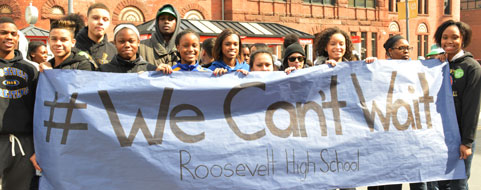

![]()


![]()
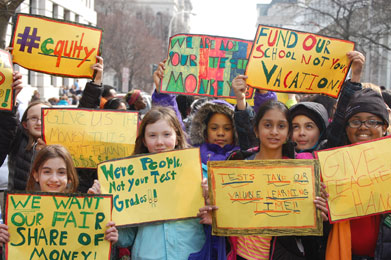

![]()


![]()

![]()

![]()


![]()

![]()


![]()


![]()
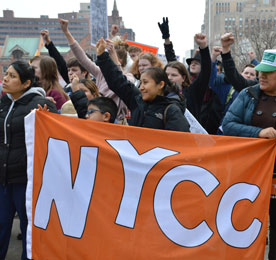

Rally at Cuomo's Office in Senate Building
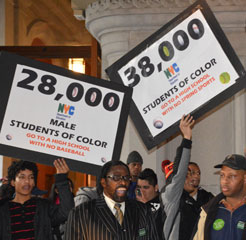
![]()
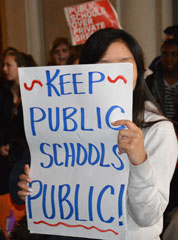

![]()
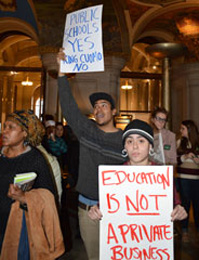
Among Cuomo’s plans are having the state — not teachers and education professionals actually in the schools — take over hiring and firing of teachers. This includes having the Common Core student test scores account for 50 percent of teacher evaluations. The tests are notorious for being unfair and designed, as the state admits, to guarantee high levels of failure. They are a means to punish students and teachers, especially veterans, who resist and defend the right to education. State control will lower quality, not raise it.
Cuomo also wants to impose the bribery of “performance bonuses,” where the state decides what “good performance” is and is not, for teachers and schools alike. Such bonuses are known to impose a culture of competition, favoritism and punishment, when what is needed is cooperation and fairness. What is needed is action to defend the equal right to education for all. This includes having Cuomo immediately pay the almost $6 billion owed since 2007! And as many youth brought out, We Want the Money Now! School boards, superintendents, teachers and parents across the state are all making clear that the $1.1 billion Cuomo proposes is not even close to what is required.
Buffalo is a main target for Cuomo, in part because through the organizing and united actions that have taken place, there is strong and broad resistance. And it is advancing the demand Our Schools, We Decide! That is, it is a movement that demands funding and raising the quality of public schools AND puts forward how this is to be accomplished — We Decide. We, the people, the parents, teachers, staff, students and organized forces defending rights, decide. We, the public, serving the interests of the public, decide. As all those who made the trip to Albany showed, we are not intimidated by Cuomo or local officials. We are stepping up the fight for the equal right to education for all. We urge all concerned to join in.
[TOP]
Buffalo School Officials Attempt to Block Trip to Albany
A Lesson in Hypocrisy and Double Standards
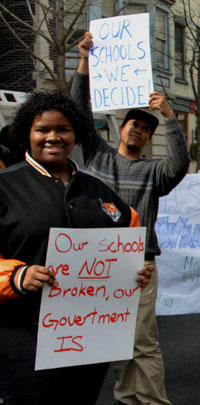 Webster’s dictionary defines hypocrisy as: “The behavior of people who do things that they tell other people not to do; behavior that does not agree with what someone claims to believe or feel.”
Webster’s dictionary defines hypocrisy as: “The behavior of people who do things that they tell other people not to do; behavior that does not agree with what someone claims to believe or feel.”
Webster’s dictionary defines double standard as: “A set of principles that applies differently and usually more rigorously to one group of people or circumstances than to another.”
Officials of the Buffalo Public Schools (BPS), including the Superintendent, the School Board as a whole and administrators have a responsibility to act with integrity and fairness, toward students, teachers and the public as a whole. Instead, recent actions of the Superintendent and other officials provide a lesson in hypocrisy and double standards.
The facts are as follows. Teachers, students and organizers mobilized for weeks to fill buses for the rally in Albany March 11, which brought people together from across the state to defend the right to education. Organizing in Buffalo this year extended to a number of schools, including City Honors, Lafayette, McKinley, MST, Riverside, 53 and 74. Such trips, with participants from various schools, have been made for several years now with support from BPS.
This time, however, was different. This time the Superintendent said no. Waiting until just days before the trip, the Superintendent sent out a letter to all principals saying the Buffalo Public Schools did not support the trip. He did this despite the fact that the action provided a lesson in governance, in public service, in how to stand up for what you believe in. These are all important and positive educational lessons, supported in the past. Other administrators said students should not participate in lobbying, as that was an adult activity.
The Superintendent then went further, just a day before the action, warning teachers that they could not travel on the same bus with their students! Evidently, officials were worried about the positive lesson such teachers were providing. Despite these efforts at intimidation, busloads of students attended the rally (see report and photos above).
 As one part of the action, some Buffalo students met with New York Senator Kennedy and other legislators. Senator Kennedy sent out a photo standing with the students. Now just guess who used these photos to promote the Buffalo Public Schools and their students? BPS officials and administrators! The same ones who said no, who claimed lobbying was an adult activity, now, for their purposes, think it is just great.
As one part of the action, some Buffalo students met with New York Senator Kennedy and other legislators. Senator Kennedy sent out a photo standing with the students. Now just guess who used these photos to promote the Buffalo Public Schools and their students? BPS officials and administrators! The same ones who said no, who claimed lobbying was an adult activity, now, for their purposes, think it is just great.
A clearer lesson in hypocrisy and double standards could not be had. When it comes to students, the Superintendent and officials said no we do not support you, you cannot get credit, cannot get an excused absence, cannot get community service — all of which are standard for such activities. No, teachers, you had better not encourage your students or ride with them. Ah, but when Senator Kennedy is involved, well then of course we support it!
Buffalo was the only school district statewide that faced such opposition. This effort at blocking participation was likely taken because the Superintendent and other school officials have been confronted by an outraged and mobilized public, demanding to have a say in the public schools and refusing to accept school closures and attacks on teachers and students alike. This was seen in rallies and packed board meetings of hundreds, with the unifying stand, Our Schools, We Decide!
The organizing for Albany this year, given the broad organizing that preceded it, included additional schools, like City Honors and McKinley. It included more organizing by the students themselves. It included students and teachers together participating and speaking out at the rallies and board meetings leading up to March 11. This unity and fighting spirit has school officials scared. But contending with a difficult situation and fear is precisely when one is supposed to have the greatest integrity. That is when it is tested. For the Superintendent and all those who opposed participation in the Albany trip, they failed the test. They instead showed their hypocrisy and double standards.
We urge all to reject the actions by BPS officials and join in demanding that the Superintendent:
1) Publicly apologize at the next school board meeting for threatening and trying to stop students and teachers from participating in the March 11 Albany action;
2) Provide all those students who went with an excused absence and community service as appropriate;
3) Establish as BPS policy support for such actions in the future.
[TOP]
Cuomo’s Effort to Block Public Control
State Receivership Is No Solution
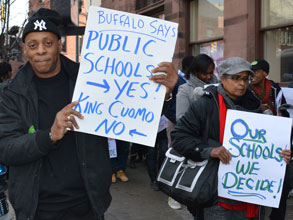 New York Governor Cuomo has called for the use of state receivership over entire school districts in the state. He has named Buffalo as a main, and perhaps the first target for such receivership. In his state of the state Cuomo put it this way: “When a school fails for three years, a nonprofit, another school district, or a turnaround expert must take over the school. That entity will have the authority to: Overhaul the curriculum; Override agreements to terminate under-performing staff; Provide salary incentives to recruit high-performing educators; Obtain priority over Pre-K, extended learning time, community schools, Early College High Schools, and other State grant programs.” The large majority of Buffalo schools would already qualify for such takeover.
New York Governor Cuomo has called for the use of state receivership over entire school districts in the state. He has named Buffalo as a main, and perhaps the first target for such receivership. In his state of the state Cuomo put it this way: “When a school fails for three years, a nonprofit, another school district, or a turnaround expert must take over the school. That entity will have the authority to: Overhaul the curriculum; Override agreements to terminate under-performing staff; Provide salary incentives to recruit high-performing educators; Obtain priority over Pre-K, extended learning time, community schools, Early College High Schools, and other State grant programs.” The large majority of Buffalo schools would already qualify for such takeover.
On February 12 his office called on the Board of Regents to investigate the “Massachusetts receivership model,” with the Lawrence Public Schools the main example. This model gives complete control to a single appointed individual to decide all matters not just generally in the district but for each individual school. The receiver decides budget, curriculum, length of day and year, hiring and firing of principals, teachers and all board staff, salaries, merit pay, discipline, etc. He can decide to work with teachers or not, has power to show favoritism, to punish individuals and schools, to close schools, turn buildings over to charters, etc. All decisions rest in the hands of a single individual not accountable to parents, students, teachers, staff in the district, but to Cuomo.
An Attack on United Stand: Our Schools, We Decide!
Receivership is a means to directly attack the broad resistance and united stand that has developed in Buffalo: Our Schools, We Decide! The public as a whole and its demand for decision making is to have no place. Collective action by the public, such as that seen at recent board meetings, is to have no place. A receiver could decide to have no public meetings. Or, like the Control Board, have 3-4 meetings a year where the public can speak but the board is not obligated to answer or in any way submit to the will of the public.
A main aim in general, using the Lawrence example, is to eliminate independent collective action, by teachers and students. Collective action defending collective rights is the basis for affirming individual rights. Blocking it harms both collectives and individuals. Instead of united, district-wide actions, teachers and principals are to limit their concerns to their individual school and join the receiver in competing for financial and other rewards he alone chooses to give out.
The recent struggle in Buffalo has made clear that common united action for rights, of collectives, including the public as a whole, is what is most needed in today’s world. Fighting together for the equal right to education for all demands cooperation and working together for the public interest. Public Control of Public Schools is what will move education in Buffalo forward. Expanding and enhancing the role of the public in decision making will move education forward. Receivership serves to do the opposite. It serves to eliminate decision making by the public, eliminate independent, united collective actions for rights and basically eliminate our schools as public institutions.
Receivership Imposes Common Core Regime
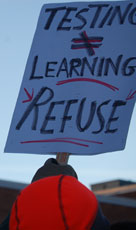 The Massachusetts model is also one based on implementing the Common Core “standards” and its testing and evaluation regime. Common Core and its testing regime is the weapon that has paved the way for the broad attack on public education and opened the way for state receivership. It is what has been used to impose a testing regime considered child abuse by parents, students and teachers alike. It has imposed a narrow curriculum and non-thinking manner for reading material that teaches only that students are to do and think what they are told. The “scoring” for the test in New York has been designed by the state — which they admitted — to ensure 70 percent of students fail. And when students supposedly fail, so do teachers.
The Massachusetts model is also one based on implementing the Common Core “standards” and its testing and evaluation regime. Common Core and its testing regime is the weapon that has paved the way for the broad attack on public education and opened the way for state receivership. It is what has been used to impose a testing regime considered child abuse by parents, students and teachers alike. It has imposed a narrow curriculum and non-thinking manner for reading material that teaches only that students are to do and think what they are told. The “scoring” for the test in New York has been designed by the state — which they admitted — to ensure 70 percent of students fail. And when students supposedly fail, so do teachers.
The entire mechanism is anti-education and anti-public. Yet under the Lawrence receiver, all schools must submit to it, base their lessons and tests on it and submit to the state Common Core based standardize test as the only measure for “improvement” and “failure.” More than 60,000 students and parents refused the state tests in New York last year and many thousands more will do the same this year. Putting a receiver in place is a means to block this refusal and immediately punish any that participate, students, teachers and parents alike, something that is not possible at present.
Beware “Teacher Leader Teams”
In reviewing the plans of the current receiver in Lawrence, Massachusetts, it is notable that a main method used is that of “advisory” boards. In the Lawrence case this includes a “Teacher Leader Cabinet” to advise the appointed receiver. And there are “Teacher Leader Teams” at each school to work with the principals for plans for each school. No doubt the receiver has final decision making as to who is and is not a “teacher leader,” and what criteria is used to decide that. Teachers may advise, the receiver decides.
The model is similar to that used by major monopolies, like General Motors, to involve workers in “advising” how better to compete. Such models came into being at a time of broad resistance among autoworkers, just as they are not to be used during a time of broad resistance among teachers.
 It was a method introduced to block the independent collective actions of workers in their own self-interests and instead involve them in advancing the interests of General Motors in its global competition. Today, for the school-based model, the Lawrence example takes into account what is needed, and being demanded — for teachers, staff, students and parents themselves to be decision makers. It than corrupts this just demand by allowing only an “advisory” role, not a deciding one. And by instilling individual competition, among teachers and schools, and not collective action for rights. And again, there is not space for students and parents to join in deciding and in fostering united collective action in the interests of the public as a whole. The district is disintegrated instead into competing individual schools, using what is called “open architecture.”
It was a method introduced to block the independent collective actions of workers in their own self-interests and instead involve them in advancing the interests of General Motors in its global competition. Today, for the school-based model, the Lawrence example takes into account what is needed, and being demanded — for teachers, staff, students and parents themselves to be decision makers. It than corrupts this just demand by allowing only an “advisory” role, not a deciding one. And by instilling individual competition, among teachers and schools, and not collective action for rights. And again, there is not space for students and parents to join in deciding and in fostering united collective action in the interests of the public as a whole. The district is disintegrated instead into competing individual schools, using what is called “open architecture.”
These are modern times that call for modern solutions that necessarily center on decision making by the people themselves. That is the requirement of the times, that is what the Buffalo experience is demonstrating and that is the direction needed. Receivers, like czars and kings, are all relics of the past with no place in the present. To Cuomo we repeat: Our Schools, We Decide!
[TOP]
Lawrence Receivership Example and Issues of Decision Making
 Below we reprint excerpts from a letter by Jeffrey C. Riley, the state appointed receiver of the Lawrence School District in Massachusetts. Lawrence is one of the examples Governor Cuomo is utilizing as he plans a state takeover of New York State school districts, using receivership. Buffalo is a likely first target.
Below we reprint excerpts from a letter by Jeffrey C. Riley, the state appointed receiver of the Lawrence School District in Massachusetts. Lawrence is one of the examples Governor Cuomo is utilizing as he plans a state takeover of New York State school districts, using receivership. Buffalo is a likely first target.
Receivership commonly involves the Governor, or state education commissioner, or similar executive appointing a single individual with broad powers to make decisions — dictate to — a school district. Elected governance is eliminated. The receiver’s powers commonly include budget, contracts, hiring and firing, closing schools, handing them to charters, and so forth.
As the Massachusetts education commissioner, who appoints the receivers there, put it, “Under receivership, when the state takes over, we’re no longer bound by the collective bargaining agreements or the budget and staffing decisions that have operated up until the receivership, so the state had the ability to make changes.” He added, “We have complete control over the budget. Where collective bargaining agreements are an impediment to implementing the turnaround plan, we can implement changes … and we have control over staffing.” For charters he said, “So a charter operator that’s a receiver for the state has those kinds of autonomies that they would have under a charter law. Where it’s different is they are no longer governed by a non-profit board; they are now working under contract to the state.” The appointed receiver is free to decide about what the charters can do independent of any constraints in existing charter law.
Lawrence, in particular, has a student population of about 14,000. It was the first district put under receivership by Massachusetts state officials. The letter is to the Lawrence District Faculty at the start of the 2014 school year.
Below are partial excerpts from the letter, highlighting issues of decision making by the receiver and teacher involvement, as advisors, in implementing the Common Core curriculum and testing regime. As the receiver put it: “Rigorous standards are the first pillar of high-quality teaching and learning.” They are to be “monitored through annual standardized testing.” And referring to his work with his Teacher Leader Cabinet on lessons, they are “Starting (as always!) from the state standards.”
The Lawrence model uses what is called “open architecture” with minimum common standards for the district as a whole and “white spaces,” where each school is given more or less “white space” to work out its plans. It also includes merit pay for teachers and using a stipend instead of regular hourly pay for longer school days. The complete letter can be found at: http://www.lawrence.k12.ma.us/users/0files/flyers/Our_Way_Forward_2.pdf
* * *
Excerpts of Letter to Lawrence Faculty from State Receiver Jeffrey C. Riley
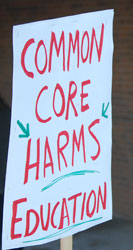 “Open architecture is fundamentally about differentiation. If differentiated instruction allows us to customize teaching to individual students’ needs, open architecture allows us to customize supports to individual schools’ needs. Our model provides broad autonomy for schools that are excelling and more intensive interventions for those schools that are not. Indeed, we recognize that the performance of our schools is on a continuum and can vary from year to year. As such, the top-down, one-size-fits-all set of policies traditionally imposed by central offices or union contracts must be made more flexible. Only then can progress be made at each school.
“Open architecture is fundamentally about differentiation. If differentiated instruction allows us to customize teaching to individual students’ needs, open architecture allows us to customize supports to individual schools’ needs. Our model provides broad autonomy for schools that are excelling and more intensive interventions for those schools that are not. Indeed, we recognize that the performance of our schools is on a continuum and can vary from year to year. As such, the top-down, one-size-fits-all set of policies traditionally imposed by central offices or union contracts must be made more flexible. Only then can progress be made at each school.
“When I first came to the district, I was focused on three things: 1) opening up “white space” for schools by clearing out former top-down policies; 2) identifying what was working in the district and expanding on it; 3) introducing schools to new practices I had seen work effectively to lift student achievement. These supports include extended time used well, including high quality student enrichment and teacher collaboration time; using student data to drive instruction; and targeted interventions that meet individual students where they are, such as acceleration academies.
“We’ve also asked every school to set its own hours and calendar for the year, create its own plan for developing common core-aligned curricula, and design its own professional development for educators. Our new teachers’ contract provides for teacher voice as a key component of this process, where Teacher Leadership Teams at each school work with the principals to set school policies. This is the core of open architecture — each school team designing the program and plan that will accelerate achievement for their students, based on the unique factors at their school.
“Now, this doesn’t mean that any proposal will fly. We maintain strong recommendations that schools choose strategies we have seen work well — whether that be sending students to the Lawrence Public Schools acceleration academies over February and April breaks or an extended day in K-8 schools. However, if principals and school teams want to propose an alternative plan that will deliver better results for students, we support and encourage that. And centrally, we provide schools with advisors who support them in making these decisions and help them look for ways to learn from one another about what is working.
“Where we are now is a district where schools set their own course. And I need each of you to be active participants moving your school forward in the coming years.
“Now, to be clear, there are times where I will intervene centrally if a school is not headed in the right direction and I do not see a clear plan in place to reverse course. When I arrived in Lawrence there were a few schools where drastic action was needed to improve student performance. And I cannot rule out that this could happen again, particularly with schools that fall to Level 4 status. In these cases, we’ve turned to innovative school models like the Oliver Partnership School, which is run in collaboration with the local and national AFT, or non-profit management organizations like Unlocking Potential or The Community Group. […]
“Open architecture is what unites us as a district, while still recognizing that each school is unique. It sets up a common model of ground rules for all schools in the district, but allows both the district and the schools to take a differentiated approach to setting each school’s program.”
 Lawrence uses the same federally-based “high” and “low” designations for their schools, using annual state tests to determine student “improvement” and school “standings.” Like in New York, the state tests have been widely opposed in Massachusetts by parents and teachers as arbitrary, anti-education, and not a tool for measuring student or teacher development.
Lawrence uses the same federally-based “high” and “low” designations for their schools, using annual state tests to determine student “improvement” and school “standings.” Like in New York, the state tests have been widely opposed in Massachusetts by parents and teachers as arbitrary, anti-education, and not a tool for measuring student or teacher development.
In Lawrence the receiver has established a “career ladder” with merit, or incentive pay. Such pay is known to greatly increase competition among teachers, not collaboration, and use of favoritism and punishment by the individual granting the pay, in this case the appointed receiver. It is also not clear on what basis, other than state test scores, a teacher is considered “advanced” or “master” or a “leader.” What is clear is that the appointed receiver decides. In his letter he brings out:
“I use a very basic tool to think about our teachers’ readiness to do the tough work of creating rigorous, engaging lessons — a diagram called the “will/skill matrix.” Ask yourself, where do you fall in this chart? [The chart has four quadrants, “low skill/low will,” “low skill/high will,” “high skill, low will,” and “high skill, high will,” VOR Ed. Note]
“This is an oft-used tool within teaching and other professions and is widely cited. I believe that when looking at both skill and will, the vast majority of our teachers today — over 95% — are great, good or working hard to improve.
“Teachers in each of these quadrants need different types of support. We need to grow educators with high will/low skill — those who are just starting in their careers and need to be developed. We need to re-enlist those with high skill but low will — talented experienced teachers who may have lost some of the zeal that attracted them to teaching. And we need to make sure we recognize, retain, and reward our best teachers — those with high skill and high will. To do this, we’ve created a career ladder with Advanced and Master roles, where great teachers can share their talents with others and earn up to $85,000. We’ve formed a Teacher Leader Cabinet, where teachers advise me on district strategy. And we have the Sontag Prize, where top teachers receive an award, professional development at Harvard, and a significant stipend to teach struggling students over school vacations.”
[TOP]
